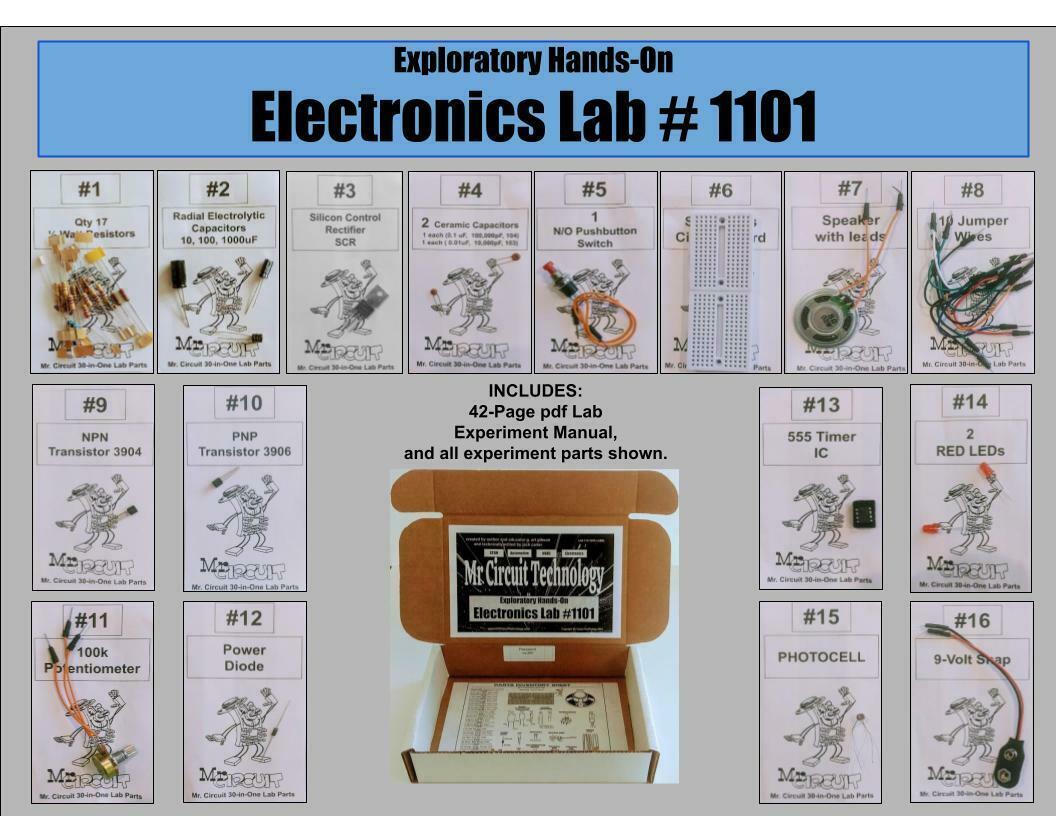-40%
Learn Electronics Tutorial Exploratory Hands-On Lab 1101 by Mr Circuit
$ 15.78
- Description
- Size Guide
Description
To view the manual for this lab, copy this link into your browser:https://cdn.shopify.com/s/files/1/0531/7305/9751/files/1101_Manual_preview_copy.pdf?v=1620687018
Learn basic electronics the easy and fun way.
With this lab you receive all the parts and a beautifully printed b/w manual with a full-color cover.
Created, printed, and packaged in the USA.
Includes 45 components to do all the experiments in the lab manual.
You have 11 hands-on lessons explaining the function of 13 electronic components. Then, with these 13 components, you build many exciting electronic projects on a solderless circuit board.
No extra parts or tools are needed All the circuits run on a 9V battery (not provided)
We ship the day we receive your order.
Introducing the
Mr Circuit Exploratory Electronics Hands-on Lab
Part # 1101
Electronics is essential in the future! Our homes, automobiles, offices, workspaces, are full of devices.
This Mr Circuit Exploratory Hands-On Electronics Lab is a way for a person to continue their adventure into the world of electronics technology. This is one the finest labs ever created to teach the basic concepts and the function of the most commonly used electronic components.
One of the reasons that this lab has been so successful is that not only are you learning but it is enjoyable.
You will learn about and use: (1) batteries, (2) switches, (3) resistors, (4) potentiometers, (5) photocells, (6) ceramic capacitors, (7) electrolytic capacitors, (8) diodes, (9) LEDs, (10) SCRs, (11) NPN and PNP transistors, (12) 555 timer integrated circuits, and (13) Speakers. You will learn how they work and their schematic symbols.
The lab manual starts by explaining electron theory; introduces the physical appearance; and schematic symbol for all of the 13 most common components; explains the Resistor Color Code and how to use it; and, shows you how to use the Solderless Circuit Board.
There are 11 lessons demonstrating the use of each of these 13 components.
Then, the rest of the lab manual contains clever and exciting electronic circuits that you build with these 13 components.
Here are the electronic circuits included in this lab.
Burglar Alarm, Automatic Night Light, DC to DC Power Supply, Electronic Metronome, Electronic Motorcycle, Railroad Lights, Variable Speed Lights, Continuity Tester, Audio Generator, Electronic Police Siren, Wake-Up Alarm, Variable Timer, Moisture Detector, Code Oscillator, Audible Water Detector, English Police Siren, Space Machine Gun, and Ultrasonic Pest Repeller.
Not only can you build these circuits, but you are given an explanation of how each one works.
The complete Mr Circuit Exploratory Electronics Lab comes with a pdf file of the lab manual, and everything needed to do all the lessons and experiments.
You will need your own 9-volt battery (not included).
When you purchase this lab, you are given permission to print a copy of the lab manual for your personal use and you can use the pdf file on your computer any time you want to as a guide to the experiments and lessons.
G. Art Gibson, Author and Educator
Upon completion of this EXPLORATORY ELECTRONICS Lab # 1101, the student will be able to:
• Draw an atom and label each element.
• Describe electron flow in a simple circuit.
• Draw a simple circuit schematic and identify the elements required for current to flow.
• Draw and identify basic electronics symbols.
• Read the Resistor Color Code and determine the values of resistors.
• Discuss the concepts and principles of a solderless circuit board.
• Construct circuits on a solderless circuit board.
• Correctly read the values of ceramic disc and electrolytic capacitors.
• Select the correct components and build an electronic circuit.
• Build a basic circuit using a potentiometer.
• Understand and use a photocell in an electronic circuit.
• Construct a circuit using a schematic diagram.
• Understand how and when to use a capacitor in an electronic circuit.
• Use a transducer like a speaker to make sounds from electron flow in a circuit.
• Know why you hear a clicking sound in a speaker when you connect and disconnect a circuit.
• Understand how the Gate in an SCR works and how to use it in an electronic circuit.
• Build a two-transistor oscillator with a PNP and an NPN transistor.
• State the function of a resistor and recognize its schematic symbol.
• State the function of a capacitor and recognize its schematic symbol.
• State the function of a power diode and recognize its schematic symbol.
• State the function of bipolar transistors and recognize its schematic symbols.
• State the function of a switch and recognize its schematic symbol.
• Understand the uses of a 555 Timer Integrated Circuit and how to use it to make an oscillator.
• Build an SCR Checker on a solderless circuit board.
• Build an NPN and PNP bipolar Transistor Checker.
• Build a Diode checker on a solderless circuit board.
• Troubleshoot electronic circuits by comparing the schematic to the physical circuit.
• State the 11 most common electronics components in use in electronics and their functions.
• Build a Variable Timer, Moisture Detector, Audio Generator, and more.
Order today and it will shipped today.

















